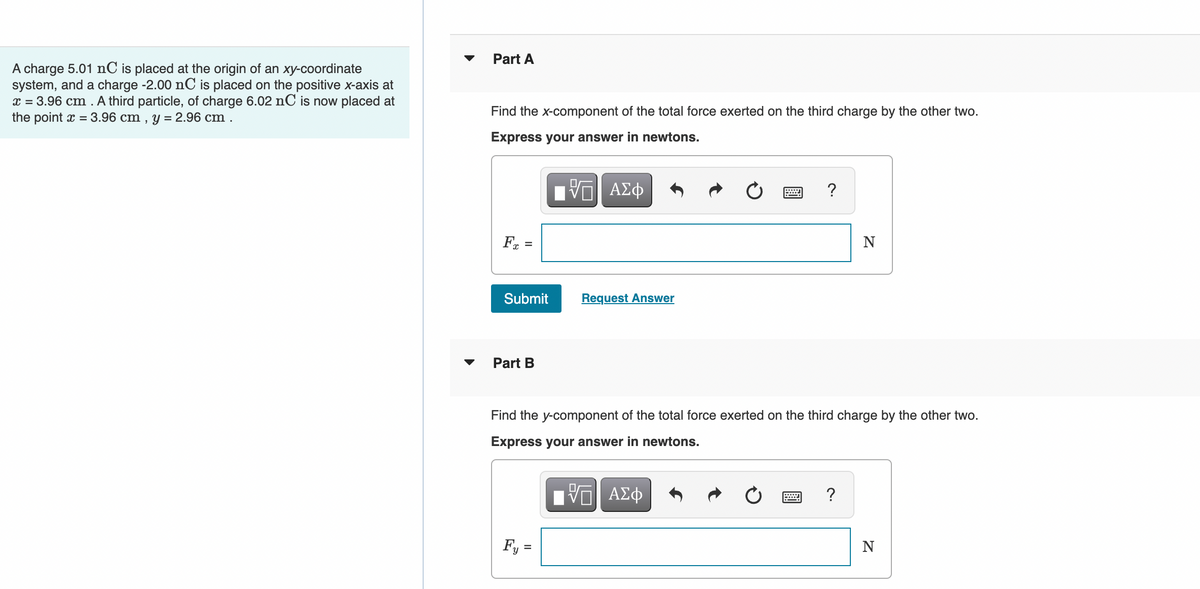Part A A charge 5.01 nC is placed at the origin of an xy-coordinate system, and a charge -2.00 nC is placed on the positive x-axis at x = 3.96 cm . A third particle, of charge 6.02 nC is now placed at the point x = 3.96 cm , y = 2.96 cm Find the x-component of the total force exerted on the third charge by the other two. Express your answer in newtons. ΑΣφ ? F. = N Submit Request Answer
Part A A charge 5.01 nC is placed at the origin of an xy-coordinate system, and a charge -2.00 nC is placed on the positive x-axis at x = 3.96 cm . A third particle, of charge 6.02 nC is now placed at the point x = 3.96 cm , y = 2.96 cm Find the x-component of the total force exerted on the third charge by the other two. Express your answer in newtons. ΑΣφ ? F. = N Submit Request Answer
Physics for Scientists and Engineers: Foundations and Connections
1st Edition
ISBN:9781133939146
Author:Katz, Debora M.
Publisher:Katz, Debora M.
Chapter23: Electric Forces
Section: Chapter Questions
Problem 54PQ
Related questions
Question

Transcribed Image Text:▼
Part A
A charge 5.01 nC is placed at the origin of an xy-coordinate
system, and a charge -2.00 nC is placed on the positive x-axis at
x = 3.96 cm . A third particle, of charge 6.02 nC is now placed at
the point x = 3.96 cm , y = 2.96 cm .
Find the x-component of the total force exerted on the third charge by the other two.
Express your answer in newtons.
ΗV ΑΣφ
?
Fa =
N
%3D
Submit
Request Answer
Part B
Find the y-component of the total force exerted on the third charge by the other two.
Express your answer in newtons.
?
Fy =
N
Expert Solution
Step 1
Given:
Solution:
The electrostatic force exerted on charge q3 due to charges q1 and q2 will be given as:
( i ) For force exerted by charge 1 on charge 3 is given as:
( ii ) Force force exerted by charge 2 on charge 3 is given as:
Trending now
This is a popular solution!
Step by step
Solved in 2 steps

Knowledge Booster
Learn more about
Need a deep-dive on the concept behind this application? Look no further. Learn more about this topic, physics and related others by exploring similar questions and additional content below.Recommended textbooks for you

Physics for Scientists and Engineers: Foundations…
Physics
ISBN:
9781133939146
Author:
Katz, Debora M.
Publisher:
Cengage Learning

Principles of Physics: A Calculus-Based Text
Physics
ISBN:
9781133104261
Author:
Raymond A. Serway, John W. Jewett
Publisher:
Cengage Learning

College Physics
Physics
ISBN:
9781305952300
Author:
Raymond A. Serway, Chris Vuille
Publisher:
Cengage Learning

Physics for Scientists and Engineers: Foundations…
Physics
ISBN:
9781133939146
Author:
Katz, Debora M.
Publisher:
Cengage Learning

Principles of Physics: A Calculus-Based Text
Physics
ISBN:
9781133104261
Author:
Raymond A. Serway, John W. Jewett
Publisher:
Cengage Learning

College Physics
Physics
ISBN:
9781305952300
Author:
Raymond A. Serway, Chris Vuille
Publisher:
Cengage Learning

College Physics
Physics
ISBN:
9781285737027
Author:
Raymond A. Serway, Chris Vuille
Publisher:
Cengage Learning

Physics for Scientists and Engineers, Technology …
Physics
ISBN:
9781305116399
Author:
Raymond A. Serway, John W. Jewett
Publisher:
Cengage Learning